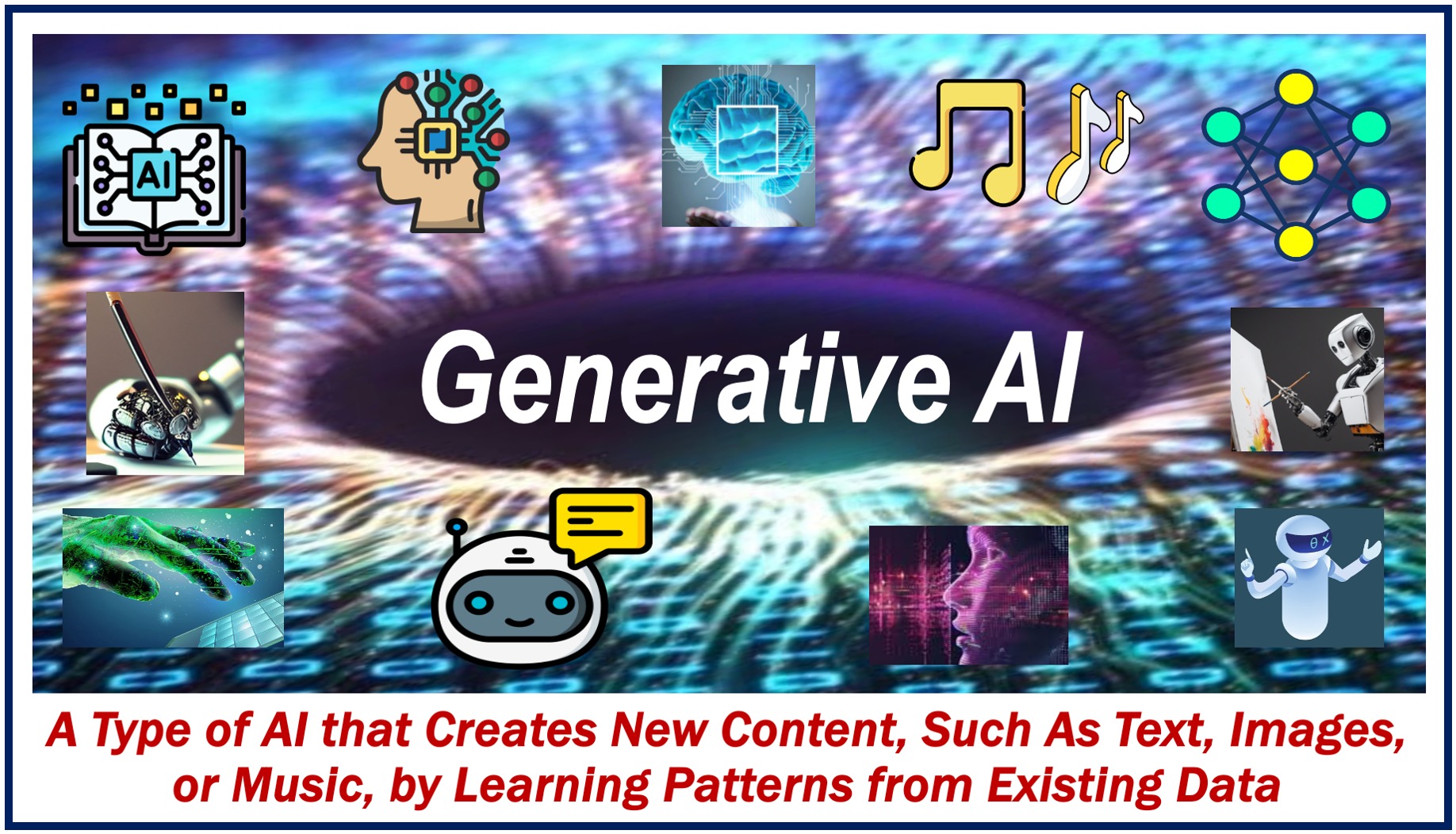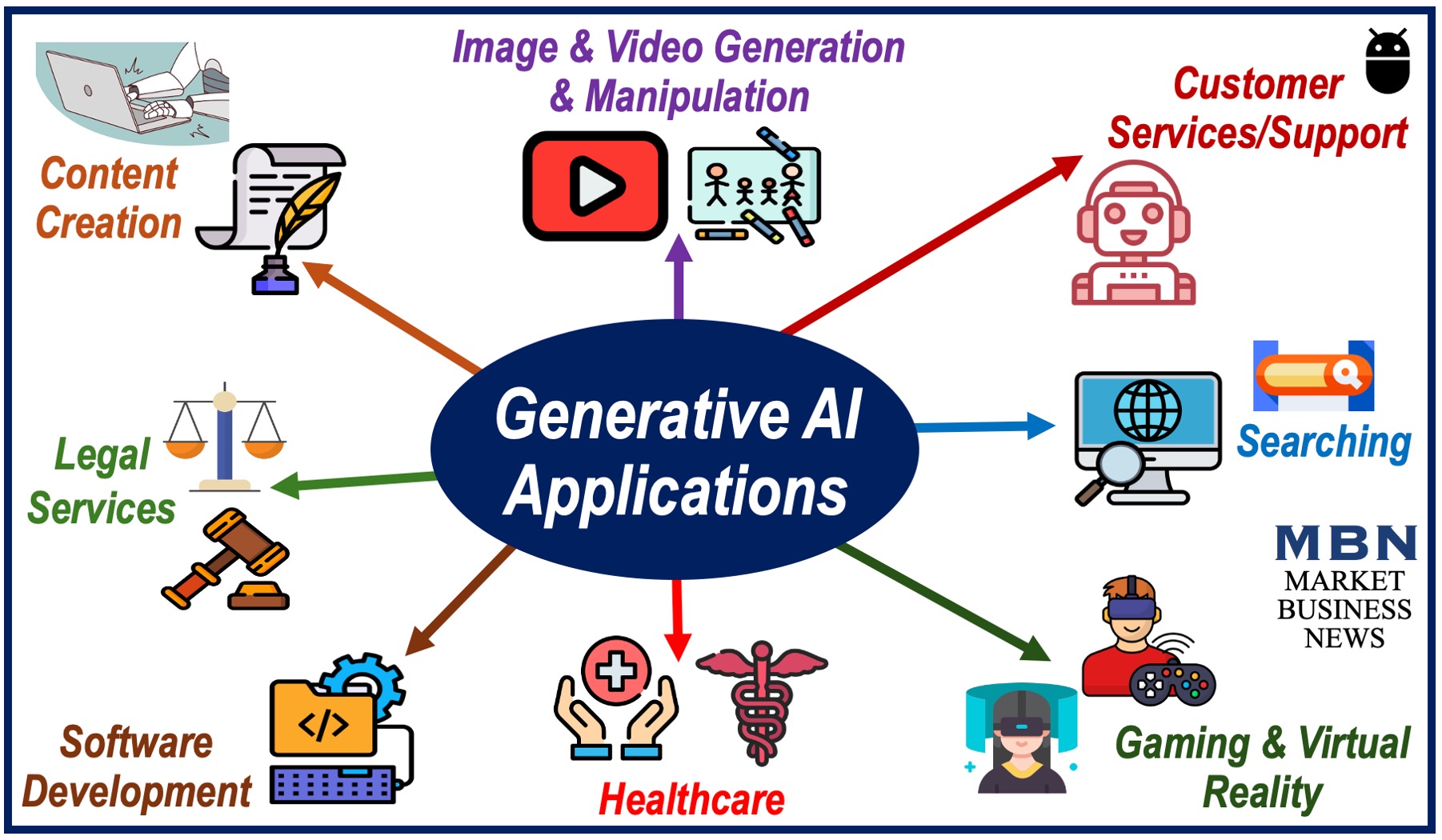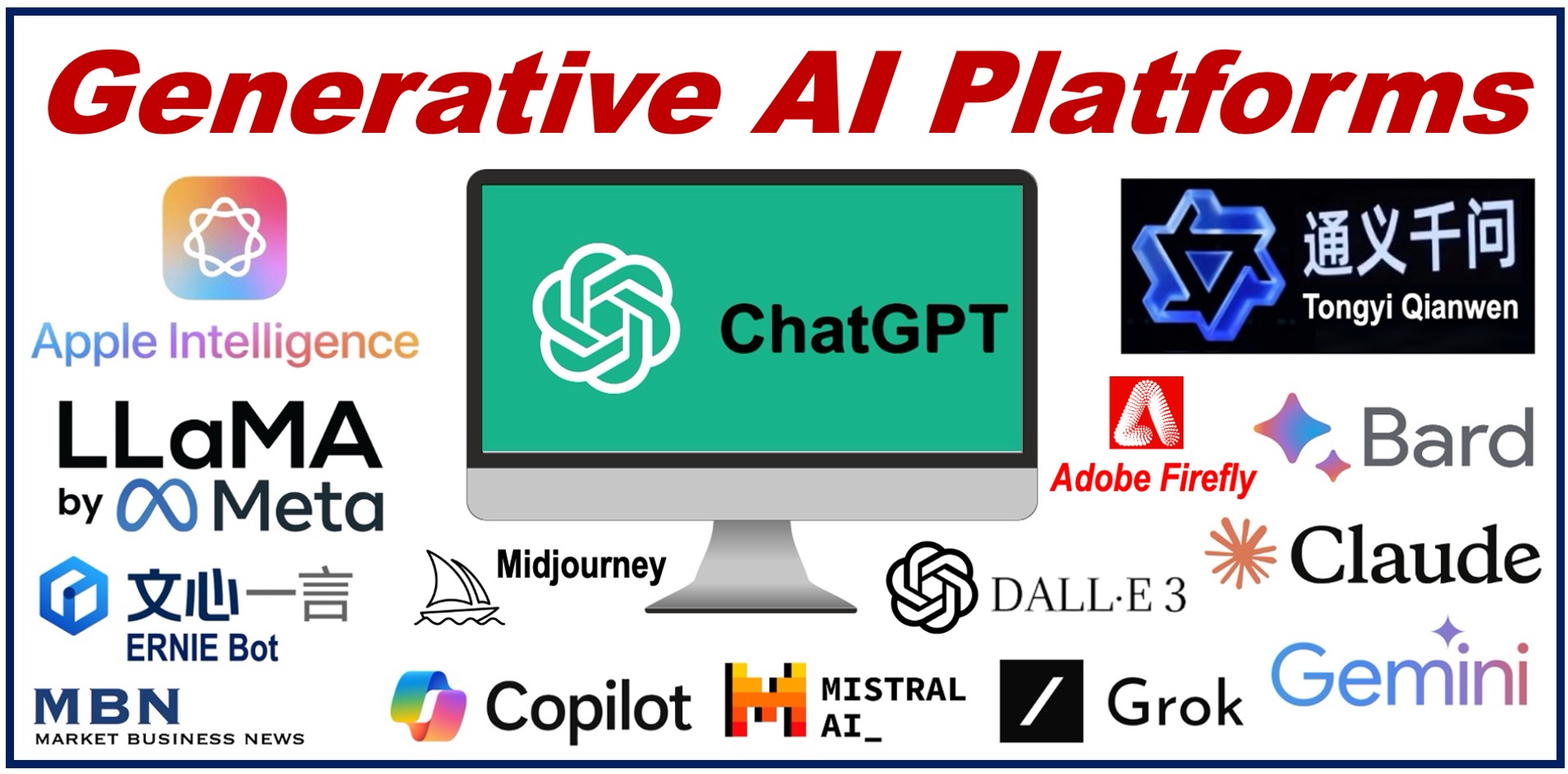Generative AI, or Generative Artificial Intelligence, is a branch of AI that can create text, images, audio, video, and even code. It creates or ‘generates’ them from vast amounts of data that it has been trained on.
It is different from traditional AI models, which generally focus on gathering, analyzing, or predicting data. Generative AI goes a step further: it generates new human-like data, that is, data that appears to have been produced by us.
In an article published by MIT News, Adam Zewe wrote the following about generative AI:
“Generative AI can be thought of as a machine-learning model that is trained to create new data, rather than making a prediction about a specific dataset. A generative AI system is one that learns to generate more objects that look like the data it was trained on.”
This relatively new technology has wide-ranging applications and is revolutionizing how we interact with digital content.
How Does Generative AI Work?
Generative AI operatives using advanced machine learning techniques, primarily deep learning and neural networks. Before we continue, let’s take a brief look at what machine learning, deep learning, and neural networks are:
-
Machine Learning and Neural Networks
The following quote comes from one of our previous articles:
“Machine learning is an artificial intelligence application that gives ‘smart’ machines the ability to learn and improve automatically. They improve from experience, even though computer scientists had not programmed them explicitly for certain tasks.”
Machine learning models are algorithms that learn from data and improve their performance over time. The AI learns on its own, without human help or input.
There is a specific type of machine learning that generative AI relies on called deep learning. Deep learning is an AI technique inspired by the human brain’s structure and how it works.
Deep learning utilizes layers of interconnected nodes (neurons), or neural networks, that process and learn huge amounts of data. Neural networks are sets of algorithms that have been modeled after the human brain. They have been designed to recognize patterns.
In other words, generative AI relies on a specific type of machine learning called deep learning, which uses artificial neural networks to simulate how the human brain processes information.

-
Training on Large Datasets
Generative AI models are trained on extensive datasets, huge blocks of data, often containing billions of pieces of content, such as text, images, or audio.
A model designed to generate text, for example, may be trained on vast collections of books, journals, and articles. By analyzing this data, the model learns patterns and structures that it is then able to use to generate new, realistic content when asked to do so.
-
Transformers and Self-Attention
A major breakthrough in generative AI was the development of transformer models. Transformers use “self-attention,” a mechanism that allows the model to understand the relationships between all elements in a sequence of data.
A transformer can, for example, produce coherent and contextually relevant text by considering the context of each work in a sentence.
-
Popular Generative AI Techniques
-
Generative Adversarial Networks (GANs)
In this technique, two neural networks compete against each other. One generates content, while the other evaluates it. This process goes on and on until the generated content is highly realistic.
-
Variational Autoencoders (VAEs)
VAEs generate new data by learning the distribution of the input data and creating variations of it.
-
Diffusion Models
Diffusion models create content in steps. They start with noisy samples (random and unclear information) and gradually make it clearer and more detailed. Realistic images are often created using this technique.
-
Large Language Models (LLMs)
These models, like GPT (Generative Pre-trained Transformer), use billions of parameters to generate human-like text.
The letters “GPT” of the popular generative AI platform ChatGPT stand for “Generative Pre-Trained Transformer.”
Applications of Generative AI
Although generative AI has only been widely available for a few years, it already has numerous practical applications across various industries. Here are some of the most common:
-
Content Creation
Generative AI has become a useful tool for writers, artists, and marketers looking to produce content efficiently.
It can write articles, create marketing copy, compose music, produce realistic voices, generate video content, design products, or generate art.
-
Customer Service and Chatbots
AI-powered chatbots, such as ChatGPT, can engage in human-like conversations with customers, answering their questions and providing overall support.
An increasing number of companies are using them in their call centers for automated customer service.
In the past, it would not have been feasible for a small business to offer 24/7 customer support. Ever since generative AI came onto the scene, this is no longer the case.
Chatbots have become valuable tools that enhance the services that businesses can offer to their customers, inquirers, and consumers in general.
-
Image and Video Generation
Tools like DALL-E and Midjourney generate images from textual descriptions.
This technology has become increasingly popular among graphic designers, advertising professionals, educators, architects, interior designers, retailers, and even creators of movies and video games for producing photorealistic images.

-
Healthcare and Medicine
Generative AI is currently being used to develop new drug compounds, create personalized treatment plans, predict disease outbreaks, optimize clinical trial designs, generate patient-specific health insights, and simulate medical procedures.
It can also generate synthetic medical images for training purposes, reducing the need for real patient data.
-
Software Development
AI models like GitHub Copilot can help software engineers and programmers become more productive by generating code snippets, suggesting improvements, and even assisting in debugging.
Apart from helping speed up the software development process, they can also reduce the number of mistakes and improve code accuracy, leading to more reliable and error-free software solutions.
-
Gaming and Virtual Reality
Game developers use generative AI to create lifelike characters, design virtual worlds, generate immersive soundscapes, customize player experiences, and even write dialogue for non-playable characters (NPCs).
Apart from helping developers work more efficiently, it can also enhance the gaming experience for customers.
Benefits of Generative AI
Generative AI offers many advantages for businesses, customers, and other stakeholders. Let’s take a look at some of them:
-
Efficiency
It automates time-consuming tasks, allowing us to focus on more complex activities.
-
Creativity
Generative AI can serve as a source of inspiration, generating new ideas, concepts, and strategies for artists, writers, designers, marketing and advertising executives, architects, educators, and product developers.
-
Scalability
Businesses can produce content at scale, such as personalized marketing messages or customized product recommendations.
If you have a small business that starts to grow rapidly, generative AI can help you keep up with increasing demands.
-
Cost Savings
Tasks that were once done by humans, who require salaries, paid vacations, etc., can now be automated.
Generative AI can save your business a lot of money, especially in the fields of content production, customer service or support, data analysis, software development, and marketing/advertising.
Limitations and Concerns
Like everything else in life, generative AI also has some challenges and potential drawbacks:
-
Inaccuracy and Hallucinations
Although generative AI can help improve efficiency and accuracy, it can sometimes produce incorrect or misleading information.
When it generates content that sounds plausible but is factually incorrect, we call it “hallucination.”
-
Bias and Fairness
AI models are only as good as the data they are trained on. The data may include biases.
If not managed properly, these biases can be reflected in the generated content, or even amplified, leading to ethical concerns.
-
Copyright and Plagiarism
Some major publications such as the New York Times, Chicago Tribune, Denver Post, Wall Street Journal, and New York Post have voiced concerns about plagiarism in content created by AI.
Over the last couple of years, several newspapers have filed lawsuits.
-
Security Risks
It is possible to use generative AI to create deepfakes or convincing but fraudulent content.
In 2022, a deepfake video of Ukrainian President Volodymyr Zelensky falsely showed him telling his troops to lay down their arms and surrender during the war with Russia. The video circulated on social media but was fortunately debunked quickly.
-
Data Privacy
Creators of generative AI use sensitive data to train models, which can lead to data privacy concerns. They must ensure that they are complying with data protection laws.
They need to comply not only with the laws of the country in which they are based but also with the laws of the nations where people are exposed to the generated content.
Future of Generative AI
Over the last two years, since generative AI became widely available, it has been keenly embraced by businesses, students, educators, researchers, content creators, and healthcare professionals.
One can only imagine what it will be like in five, ten, or thirty years’ time, and its impact on our lives.
Researchers are currently working to improve the accuracy, creativity, and ethical use of this technology. Potential advancements over the near future include:
-
More Human-Like Interactions
As AI models improve, the conversations we will have with them and the content they generate will become more natural and engaging.
-
Better Personalization
AI will become better at tailoring content according to each individual’s preferences and needs.
-
Safer and More Transparent Models
A lot of work is currently going into making AI models bias-free, more explainable, and more trustworthy.
-
Integration Across Industries
We can expect generative AI to be integrated into fields like architecture, engineering, and education, revolutionizing how professionals work.
-
The Global Economy
The following quote comes from aws.amazon.com:
“According to Goldman Sachs, generative AI could drive a 7 percent (or almost $7 trillion) increase in global gross domestic product (GDP) and lift productivity growth by 1.5 percentage points over ten years.”

Major Generative AI Tools
Over the last couple of years, many new generative AI tools have emerged. Below is a list of ten of them (there are many more):
-
ChatGPT
Developer: OpenAI
Release Date: November 2022
Description: Text generation and conversation.
-
DALL·E 3
Developer: OpenAI
Release Date: September 2023
Description: Text-to-image creation.
-
Midjourney
Developer: Midjourney, Inc.
Release Date: July 2022
Description: Artistic image generation.
-
GitHub Copilot
Developer: GitHub (Microsoft)
Release Date: June 2021
Description: Code assistance for developers.
- Adobe Firefly
Developer: Adobe
Release Date: March 2023
Description: Creative design and image generation.
-
Stable Diffusion
Developer: Stability AI
Release Date: August 2022
Description: Image synthesis from text prompts.
-
Tongyi Qianwen
Developer: Alibaba Cloud
Release Date: April 2023
Description: Multilingual text generation.
-
Mistral
Developer: Mistral AI (France)
Release Date: June 2023
Description: Language model for generative tasks.
-
Gemini
Developer: Google
Release Date: December 2023
Description: Multimodal AI for text, images, and audio.
Types of AI
If you check on the Internet, you will see that there are varying numbers of AI types, depending on the source. As the technology is fairly new and changing rapidly, it is difficult to say exactly how many AI tools and what types there are at any given moment.
The information in the next two sections below – AI types based on Functionalities, and then Technology – comes from IBM (International Business Machines Corporation).
Types of AI Based on Functionalities
-
Reactive Machine AI
This type of AI has no memory. It performs specific tasks using present data only.
Examples include Netflix’s Recommendation Engine and IBM Deep Blue for chess.
-
Limited Memory AI
This AI system can use past and present data to make decisions. However, it does not store long-term experiences.
Examples include Generative AI tools like ChatGPT, virtual assistants, and self-driving cars.
-
Theory of Mind AI
This theoretical AI is still under development and not yet fully realized. It should eventually be able to understand our emotions and intentions and could potentially form human-like relationships.
-
Self-Aware AI
Self-Aware AI is currently just a concept, with no practical applications. Hypothetically, it would be self-conscious, understand human emotions and have its own.
Types of AI Based on Technologies
-
Artificial Narrow Intelligence
Also known as Weak AI, it can perform single tasks exceptionally well.
Examples include Alexa, Siri, IBM Watson, Google Assistant, Roomba, and ChatGPT.
-
Artificial General Intelligence (AGI)
Also known as Strong AI, it is a theoretical artificial intelligence that could learn and apply knowledge across multiple tasks like we (humans) can. It has not yet been developed.
-
Artificial Super Intelligence
Also known as Super AI, it is hypothetically a type of AI that surpasses human intelligence. It would be capable of independent emotions, belief, and reasoning. It is currently still a speculative concept.
Conclusion
Generative AI is reshaping our world by automating creative processes and rapidly expanding what smart machines can do.
As the technology evolves, it will help us work more efficiently and accurately.
We must ensure that the evolution of AI is managed carefully and for the good of humankind.
As AI advances, could it surpass us and potentially expose us to harm if not properly managed? We must be cautious and ensure safeguards are in place to prevent unintended consequences.
